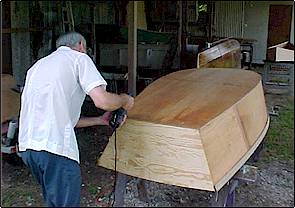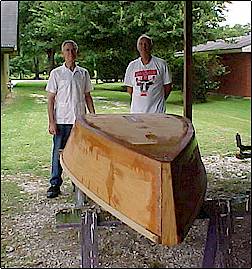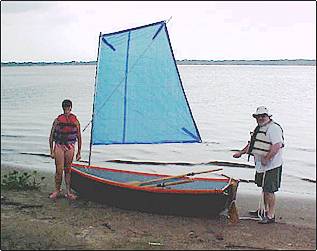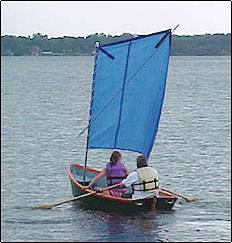Our boat, as yet unnamed by my daughters, is a ten foot skiff kit by
Uncle John of Uncle
John's General Store in Louisiana. The Lake Charles Yacht Club started
a project last summer, led by Ken Abrahams, of a boat-building class.
The class was designed to produce a boat hull in one weekend of work,
with the finishing to follow. Ken had done some preliminary work
on each kit with the help of several local businesses, and
scarfed the plywood sides and bottom to ten feet. He also put
together the necessary parts, screws, nut and bolts and cut out
rudder and centerboard parts; this made the kit very easy to
make.
 Our family was in
the throes of finishing an addition to our home last summer, and
the weekend scheduled for the class I was out of town on business.
So, Ken delivered the kit parts to my house, where they rested until
February, 2001. Mardi Gras weekend (a holiday at the college where I
teach in Louisiana!) I finally got started. I put together the sides
of the hull, put in the seats and fitted the bottom; then the
boat sat under a tarp in my back yard until summer vacation. Our family was in
the throes of finishing an addition to our home last summer, and
the weekend scheduled for the class I was out of town on business.
So, Ken delivered the kit parts to my house, where they rested until
February, 2001. Mardi Gras weekend (a holiday at the college where I
teach in Louisiana!) I finally got started. I put together the sides
of the hull, put in the seats and fitted the bottom; then the
boat sat under a tarp in my back yard until summer vacation.
This is the first boat that I have put together -- although I
enjoy building and doing finishing work. It was also the first
experience with fiberglass; I spent a fair amount of time on the
'Net looking at websites, and gleaning some great information
about working on "stitch and glue" boats. I started the
fiberglassing process in the summer months, working a couple hours a day
and learning how to do seams and work with fillers to make the epoxy
putty. I ended up doing several seams over, sanding them off
because of large air bubbles. I also ended up using about twice
as much epoxy resin as I should have, between the spots I did
over and giving the entire boat two coat of epoxy to seal the
wood.
 Finally
by the beginning of August I started the painting process. Our Stine's
Lumber Yard (one of the sponsors of the class) has a great sign in the
paint department: " No men are allowed to pick out paint colors
without a written note from their wife." After being
incredibly patient with a partially completed boat in the back
yard, taking up the picnic table and several sawhorse under the
trees in the back yard for six months, my wife exercised the
color prerogatives, and picked out the paint colors for the boat.
They are: hull (emerald green), rubrails (bright orange) and interior
(gray). I followed the directions from Uncle John on producing a
thirty-six square foot polytarp sail in a sprit rig design, using
duck tape (blue to match the tarp); the sail went together easily
and seems to work well. It is yet to be seen how well it lasts.
The mast is a piece of one-and-quarter inch chainlink fence
tubing, and the sprit pole is conduit. Finally
by the beginning of August I started the painting process. Our Stine's
Lumber Yard (one of the sponsors of the class) has a great sign in the
paint department: " No men are allowed to pick out paint colors
without a written note from their wife." After being
incredibly patient with a partially completed boat in the back
yard, taking up the picnic table and several sawhorse under the
trees in the back yard for six months, my wife exercised the
color prerogatives, and picked out the paint colors for the boat.
They are: hull (emerald green), rubrails (bright orange) and interior
(gray). I followed the directions from Uncle John on producing a
thirty-six square foot polytarp sail in a sprit rig design, using
duck tape (blue to match the tarp); the sail went together easily
and seems to work well. It is yet to be seen how well it lasts.
The mast is a piece of one-and-quarter inch chainlink fence
tubing, and the sprit pole is conduit.
The skiff was primed, and then painted with two coats of color
inside and out. After waiting 48 hours for the last coat of paint
to dry, a date was made with my 13-year-old daughter Emily to
"wet down" the boat, and try the sails. The skiff is
set up with both sail and oars, as I know that the wind will
occasionally fail me, and that there are places I will try in the
marshes around Lake Charles that will be easier with oars.
 On
Sunday, August 12, we went down to the Lake Charles Yacht Club with the
skiff in the back of my Plymouth Voyager van. No problems
transporting it, and it weighs about a hundred pounds -- easy for
two people to handle. We left the house in bright sunshine; by
the time we got to the club twenty minutes later, storm clouds
had blown in from the west. We got the boat out, and set it up on
the beach. We waited about twenty more minutes for the storm clouds
to blow through, then launched from the beach. I was very happy to see
Ken Abrahams there at the club. He has been a great support and a
wonderful friend through the process of building, and he
brought his digital camera to take pictures of the boat and the
launch! On
Sunday, August 12, we went down to the Lake Charles Yacht Club with the
skiff in the back of my Plymouth Voyager van. No problems
transporting it, and it weighs about a hundred pounds -- easy for
two people to handle. We left the house in bright sunshine; by
the time we got to the club twenty minutes later, storm clouds
had blown in from the west. We got the boat out, and set it up on
the beach. We waited about twenty more minutes for the storm clouds
to blow through, then launched from the beach. I was very happy to see
Ken Abrahams there at the club. He has been a great support and a
wonderful friend through the process of building, and he
brought his digital camera to take pictures of the boat and the
launch!
There were no visible leaks - I guess that my first time
fiberglassing seams actually worked OK. We tried the oars to get
far enough from shore, and the skiff worked very well. Dropped
the centerboard and rudder, pulled in the mainsheet, and off the
boat went. We ended up sailing up and down the beach for about
twenty-five minutes, then sailed to shore, avoiding another rain shower.
The most noticeable issue was learning the balance of the boat -- with
two people sailing it worked better to sit on the bottom of the boat
fore and aft of the center seat.
 It has
been an exciting experience building my first boat, and finally getting
in the water. As it will live down at the Lake Charles Yacht Club, I
now have an easy way to get onto the water quickly, as well as a boat
that will work for my daughters to take out. I can't wait to
start the next one! It has
been an exciting experience building my first boat, and finally getting
in the water. As it will live down at the Lake Charles Yacht Club, I
now have an easy way to get onto the water quickly, as well as a boat
that will work for my daughters to take out. I can't wait to
start the next one!
Bill Rose
Member, Lake Charles Yacht Club
Lake Charles, LA
rosebone@aol.com
|
![]()